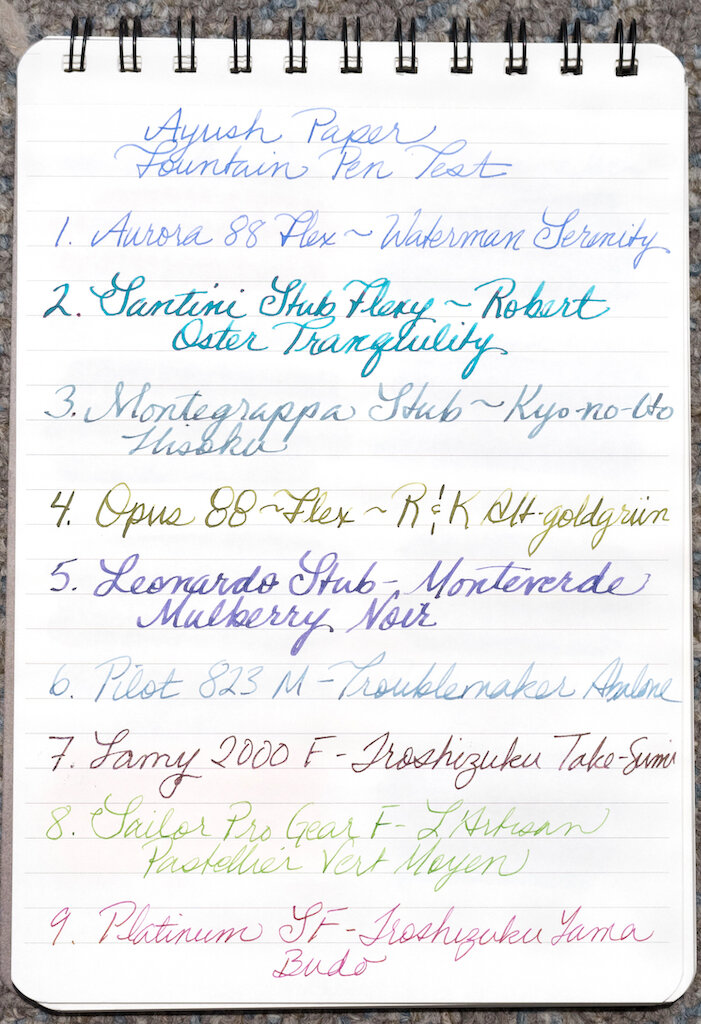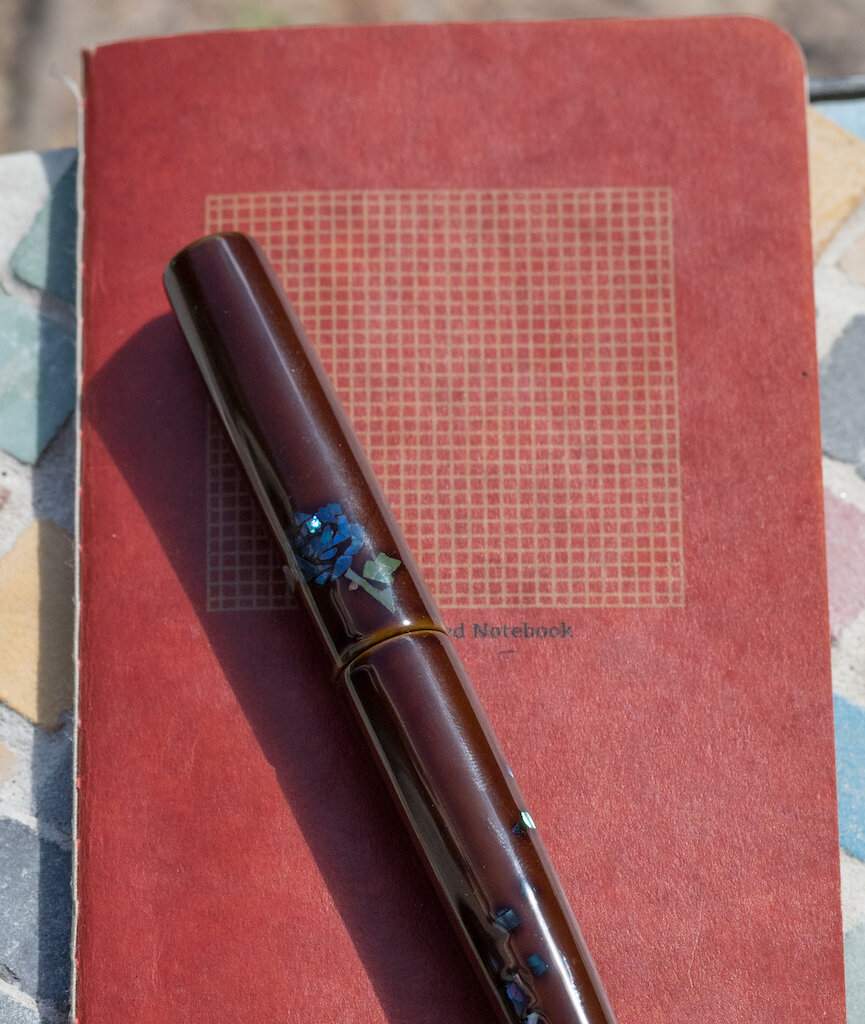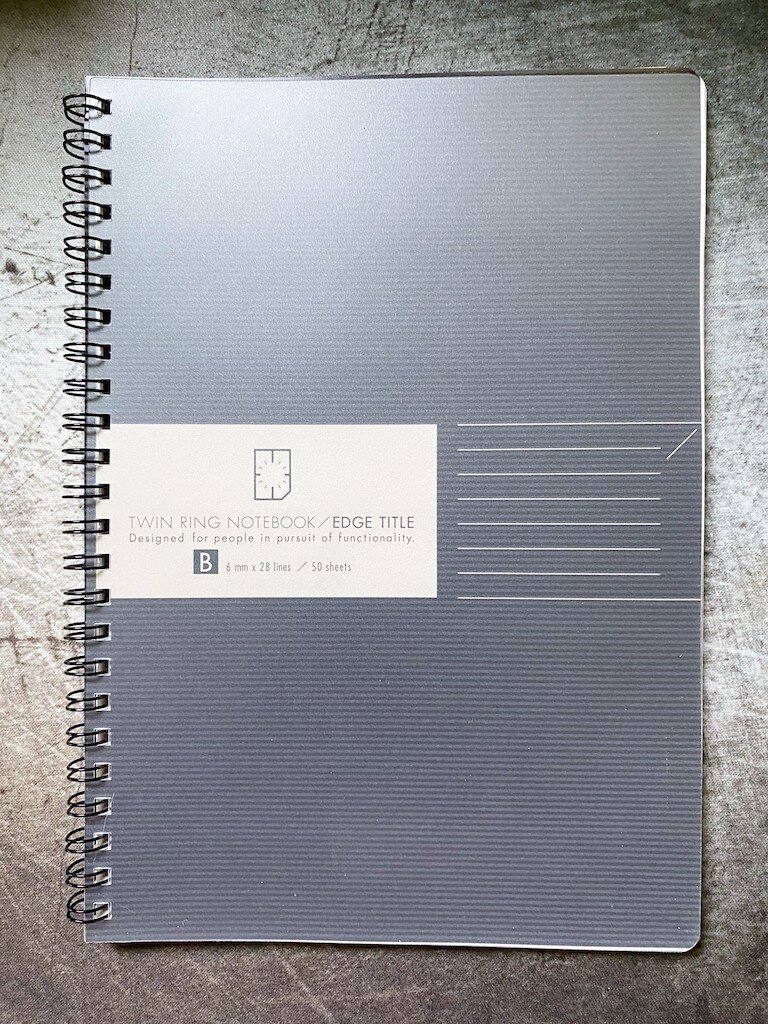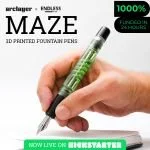(Susan M. Pigott is a fountain pen collector, pen and paperholic, photographer, and professor. You can find more from Susan on her blog Scribalishess.)
The past few years have been interesting for fountain pen users who demand a great deal from their paper. The variety and availability of fountain-pen-friendly paper seems to have exploded exponentially. Yet, at the same time, many were dismayed by the fact that Tomoe River Paper (a favorite) was changed. And recently there have been rumors that some or all Tomoe River Paper will be discontinued (see the discussion here, for example).
Consequently, it's reassuring to come across new brands that offer fountain-pen-friendly paper with unique characteristics. One such brand is Ayush Paper from India. Founded in 2012, but only recently made available outside India, Ayush Paper sells various kinds of paper and art products. Today, I'm reviewing two fountain-pen-friendly notebooks in A5 and A4 sizes.
Both notebooks are wire bound at the top which allows you to fold the pages over completely. The pages are perforated at the top so you can tear them out neatly. The A5 notebook has rounded corners but the A4 corners are left square.
The notebooks' card stock covers provide support if you don't have a writing surface. The front cover is adorned with a simple square or scrolled lines and the Ayush Paper logo. The white brush strokes (?) on the letters look like pieces of stray paper to me, and I swipe my hand across the covers trying to remove them every single time. Maybe that's just OCD me, but I find them distracting. Nevertheless, their motto, "Your fountain pen will love this paper" is absolutely true--spoiler alert!
On the back cover, the company offers reasons why you will love the notebook. I'll discuss whether or not I agree with all of the claims in my review.
The notebooks each contain 50 pages (100 front and back) of 100 gsm natural-colored paper. I could not find any information on the website discussing the paper's composition, so it's unclear whether it's made from wood pulp, cotton, hemp, or some other material. Regardless, the paper feels substantive between the fingers. In addition, it has the perfect amount of texture which gives you gentle feedback when you write. Writing on this paper is pure pleasure.
I started with the A5 notebook which has grey lines 9mm apart. I normally prefer narrower lines, but I found myself enjoying the 9mm spacing, especially with broader nibs.
The first pen I used is my brand new Santini Italia Libra with a flexy stub nib (review coming soon) inked with Robert Oster Tranquility. I started writing, and the nib and ink created an alchemy with the paper that is hard to explain. Writing is smooth, but the texture helps you sense where the nib is. I felt completely in control of each stroke. The ink displayed both shading and sheen. Although there's a little bit of show through (compared to Tomoe, it's virtually invisible), there was no feathering or bleed through. I was thoroughly impressed.
I also tested the paper with a variety of fountain pens and inks. It handled every single one beautifully. The ink colors are vibrant. Both wide nibs and fine nibs write smoothly. That texture works well with all the nibs I tested. Once again, I experienced no feathering and no bleed through. Show through was minimal.
Next I conducted a swab test with eight different inks, using mostly vibrant colors. Shading, sheen, and shimmer were all visible in the swabs, and none of the inks bled through.
I wrote a page using my Aurora 88 Anniversario Flex with Waterman Serenity Blue ink. Once again, the combination of the nib, ink, and paper texture made the experience pleasurable. There's just something about this paper that gives me more control over the nib. The show through was so minimal that I decided not to include a photo.
Next I worked with the A4 notebook, which has blank pages. I began with a calligraphy dip pen because calligraphy nibs tend to have sharp, delicate points. I wanted to see if the paper would catch on the nib. Nope. Not at all. In fact, I think I've discovered my favorite calligraphy paper. Once again, nib, ink, and paper worked flawlessly together. Granted, I'm a pretty terrible calligrapher, but this paper handled the wet ink and delicate nib perfectly. As before, there was no feathering or bleed through and just a shadow of show through even with ultra-saturated, wet Montblanc Corn Poppy ink.
I experimented with two inks using my ultra wide ruling pen. First, I used Troublemaker Milky Ocean. The paper took the wet, wide nib with grace, resulting in beautiful shading and pooling. Because the ink was wet, the paper buckled slightly, but there was no bleed through. Show through was a bit more obvious.
Last, I used my ruling pen and Lamy Dark Lilac. This ink is like liquid velvet. It came out vibrant and beautiful, with tons of sheen. However, the ink feathered and bled through the paper. Even so, none of the bleed through affected the paper beneath.
So, do I love Ayush Notebooks? You bet I do. I am completely thrilled with the paper. I agree with the reasons Ayush lists on the back of the notebooks. The natural shade of the paper is easy on the eyes but allows the vibrance and colors of the inks to display accurately. I did not experience any feathering or bleeding (except with Lamy Dark Lilac). The paper worked well with my Santini flexy stub and with my calligraphy dip pen (also a flex nib). Although some of the wetter inks in wide nibs took time to dry, overall the drying time was negligible--there's not one smear in any of my tests. Show through was indeed minimal and I could easily use both sides of the paper (with the exception of the page with Lamy Dark Lilac).
The A4 notebook costs ₹300.00 (=$4.13) and the A5 costs ₹180.00 (=$2.48). That's a steal, for sure! Be aware, however, that shipping is expensive. I put one A4 and one A5 notebook in my cart, and shipping to Texas via FedEx was ₹1870.00 (=$25.72). Still, when you consider that one Tomoe River Paper notebook can cost you between $20 and $25 without shipping, you're still getting a great deal.
I hope Ayush Paper keeps selling notebooks forever, because I am a huge fan. I did not expect to be won over by these notebooks at all. In fact, I was much more excited about the Cosmo Air Light notebook that Brad sent me (review coming soon). But I will definitely buy Ayush Notebooks in the future, especially for calligraphy.
(Ayush Paper sent these notebooks free of charge to Pen Addict for review.)
Enjoy reading The Pen Addict? Then consider becoming a member to receive additional weekly content, giveaways, and discounts in The Pen Addict shop. Plus, you support me and the site directly, for which I am very grateful.
Membership starts at just $5/month, with a discounted annual option available. To find out more about membership click here and join us!




















































